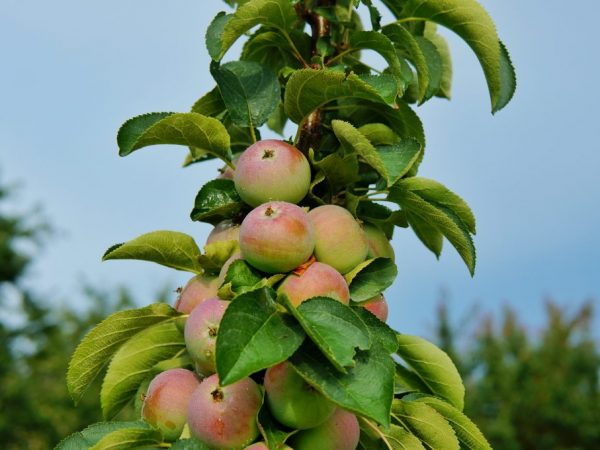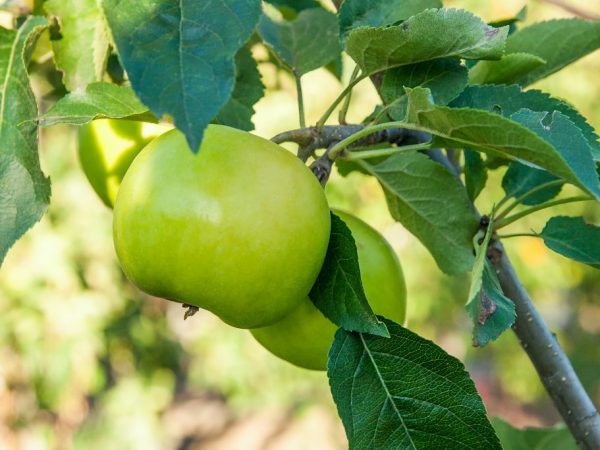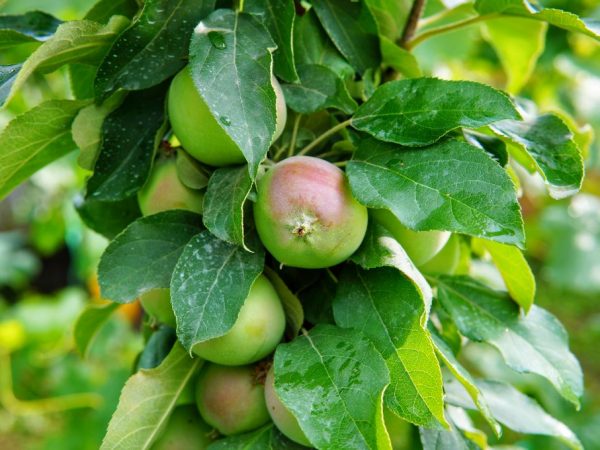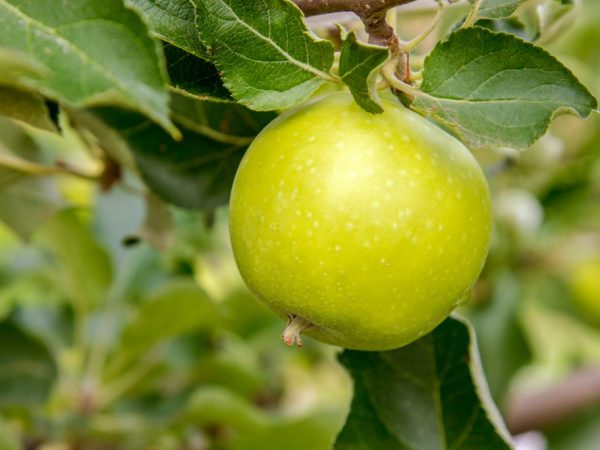Columnar apple varieties for the Urals
Columnar apple trees for the Urals are represented by a wide variety of varieties that will grow and bear fruit subject to all the rules of agricultural technology. In general, this group is valued for many factors - trees have a compact crown, do not need pruning and give stable yields.

Columnar apple varieties for the Urals
For the southern zone
Only thermophilic varieties can grow in this zone, among which the most popular are:
- Chervonets. Autumn hybrid suitable for planting in small areas. The root system of the plant is not very strong, so it does not require a lot of space in the garden. The main advantages include immunity to fungal sores and various parasites, good winter hardiness, fertility from the second year of cultivation. This culture has high decorative qualities and produces delicious and juicy apples. It is necessary to remove fruits from the tree on time, since the taste of overripe fruits deteriorates significantly and their shelf life is reduced.
- Waltz. The plant is compact, of average height - about 2.5-3 m. Fruit ovaries are formed on last year's branches and shoots of the current year. The apples are green, with a reddish cover, round in shape, they are juicy, sweet, with a slight sourness. The plant is suitable for growing in the south and southwest. Possesses good resistance to severe frosts and diseases.
- Dialog. The apples are slightly flattened, yellow in color. Average weight - 80-100 g. With good care, seedlings begin to bear fruit already in the first year of life. The yield is high - up to 15 kg of fruits can be removed from a young plant. Shelf life - up to 1 month. The hybrid has good disease and frost resistance. The culture is self-fertile, therefore it needs pollination with other plants.
For the middle zone
For this zone of the Urals, winter-hardy and undersized varieties of columnar apple trees are best suited.
Amber necklace
This drought-resistant culture is able to withstand the most severe frosts, while the above-ground parts practically do not freeze.
Fruits are harvested in September. Long-term storage - until the end of spring.
The peak of the disclosure of taste occurs 1.5 months after removal.
The tree is prolific: in one season it can give up to 20 kg of harvest. The apples are yellow-green in color, with a scarlet barrel. They are quite large - up to 200 g, and when normalizing the ovaries, you can get fruits weighing about 300 g.
The crop is prized for its longevity and annual yield for 15-16 years.
Baby
Another frost-resistant hybrid, pleases with the harvest already in the second year of life. Up to 3 kg of fruit can be removed from a young tree.
From the 5th year of life, the harvest is stable - up to 12 kg.
Fruits are small - up to 120 g, yellow-green. The taste is sweet and sour, becoming sweeter after long-term storage.

Fruits can be kept fresh until spring.
The ripening period is in the middle or end of September.The harvest is stored until spring.
Vasyugan
The most frost-resistant apple tree, which can withstand temperatures as low as -42 °.
The plant is of medium height - up to 3 m high, early maturing (the first apples ripen in the year of planting). But to strengthen the underground part and stimulate the growth of the crown, the inflorescences are cut off in the first year.
The apples are red-green, very juicy and sweet. Weigh from 100 to 200 g.
Every year the tree increases its yield: in the 2nd year of life it gives a bucket of harvest, in the 3rd - 2 buckets.
The collection is carried out in the last decade of August or in the first decade of September.
Apples are stored for only about a month, so they are immediately processed or consumed fresh.
The plant is valued for stable and long-term fruiting - for 15-16 years.
Currency
A late-ripening, undersized hybrid with compact size (height 3-3.5 m), has good resistance to severe winters and safely tolerates unfavorable weather.
Harvesting takes place in mid or late September. The apples are deep yellow with a reddish blush on the side.
The hybrid is fast-growing, begins to bear fruit in the 2nd year. The duration of the process is up to 17 years.
Nectar
Winter-hardy culture, tolerates sudden changes in temperature. Fruits with delicious and juicy fruits with a honey aroma.
The crown is compact, about 3 m high, densely covered with dark green leaves.
Possesses good resistance to scab and various fungal infections.
Iksha
Summer, early dwarf hybrid with good frost resistance and the ability to safely tolerate sudden changes in temperature.
The apples are large - from 150 to 220 g, thin-skinned, light green, have increased juiciness and sweetness.
The main advantages are:
- high frost resistance;
- long-term preservation of the crop;
- fertility;
- high immunity against various diseases.
For the northern zone

Disease resistant varieties
This group includes varieties with increased immunity to disease and fierce winters.
Gin
A compact plant up to 2 m high, has good immunity against fungal sores.
The plant is late-ripening - harvest by the end of September. Fruits are large - from 150 to 200 g, thick-skinned, rich scarlet color. They are well transported over long distances and stored for six months.
Ostankino
Columnar semi-dwarf hybrid (height 2 m), excellent for the north of the Urals - ripens in autumn (early or mid September).
The fruits are large (from 150 to 250 g), green or yellow in color with a purple barrel. They are eaten fresh and canned. Shelf life is 3-4 months in cool conditions.
The plant is early-growing - the first ovaries are formed in the 2nd year of life. The yield is high - up to 700 kg / ha. The life span of a tree is 15-16 years.
Ranet Mazherova
Mid-autumn hybrid with yellow-red fruits and medium keeping quality (up to 2 months). The fruits are small - weighing up to 100 g, the taste is sweet and sour, the pulp is juicy.
The plant tolerates wintering well in the northern zone, the first harvest gives in the fifth year of life. Harvest of universal use.
Sparkle
A short, compact and fruitful tree. It gained great popularity in the north of the Urals. This interest in culture is driven by several qualities:
- good disease resistance;
- excellent taste and marketability of fruits;
- apples lie until early spring.
The fruits are large - weighing from 180 to 200 g, yellow or light green in color with juicy and sweet pulp.
Elite
Large-fruited, dessert apple - ripens in late September or early October.
The apples are greenish-yellow, weighing from 150 to 200 g, they are fragrant, sweet and sour, juicy.

The fruit tastes good.
It enters the fruiting phase in the 2nd year of cultivation, the maximum yields are noted from the 4th year.
Arbat
The plant is late ripening with a compact aboveground part and good yield indicators - the first fruits ripen in the 5th year.
Harvesting takes place in late summer or early autumn. Fruits are slightly elongated, rich cherry color, juicy, sweet.
This crop is valued for its stable and annual yield, high resistance to scab and sudden temperature changes, and tolerates severe frosts (up to -40 °).
Among the disadvantages are poor keeping quality (about a month), crushing apples in fruitful years, poor transportability and a short life span of a tree - 14 years.
Secrets of Successful Growing
It is possible to plant columnar apple trees in the Urals both in autumn and spring.
For spring planting, the optimal time is mid or late April, in autumn - no later than mid-October.
A sunny, windless place with loamy, loose soil enriched with organic and mineral fertilizers is suitable.
It is important that the soil is slightly acidic, otherwise the tree will not be able to fully develop and bear fruit.
Dolomite flour, hydrated lime or chalk can be added to deoxidize the soil.
Choose a site at an angle - this way you eliminate the risk of waterlogging of the roots and the death of young seedlings.
You can fertilize the site before planting in the fall, during digging, or in the spring (add nutrients directly to the planting pits).
The columnar apple tree loves a balanced diet, therefore, when planting it, the following mixture is used - humus (1 bucket), wood ash (2 kg), superphosphate (50 g), potassium sulfate (50 g). This number of preparations is calculated per m².
When fertilizing the planting pits, garden soil is added to the nutrient mixture in a 1: 2 ratio.
The second option for feeding is 1 kg of mullein, dissolve in a bucket of water, leave for 5 days and shed soil with it.
Landing technique
For seedlings, planting holes are dug out with a depth of 80-100 cm, a width of 50 cm. Before planting, the hole is spilled with 2 buckets of water, then a layer of drainage from pebbles, broken brick or crushed stone is laid. A peg is driven in the center.

The seedling must be tied to a support
The hole is half covered with earth, the roots are laid on top, straightened and sprinkled with soil, thoroughly tamping the near-trunk zone. When planting a plant, you should slightly raise the root collar so that it is on the surface of the soil.
After planting, the seedlings are abundantly moistened - 2 buckets, then tied to a support and mulched with a thick layer of humus or peat.
For group planting, the scheme is followed - 50 cm between plants and 1 m between rows.
Care rules
Given the harsh and changeable climatic conditions in the Urals, columnar apple trees require good and timely care.
- Regular watering will provide plants with full life. It is produced as the surface layer of the earth dries out (at least once a week). Only in the rainy season, the frequency of watering is reduced to eliminate the risk of waterlogging.
- After each watering, the soil is loosened to prevent crust formation. You should also regularly remove weeds that take away moisture and nutrients from the seedlings.
- The first tree feeding is carried out 2 years after planting. In early spring, seedlings are fertilized with Azophos or any other nitrogen-containing preparation. This component contributes to the growth of green mass and the root system of plants. 2 weeks before and after flowering, trees are fertilized with superphosphate and potassium salt to improve flowering quality and good yields. These components are added at the stage of pouring the fruit. The last fertilization is carried out in the fall, when the plant sheds its foliage - a urea solution is used. This component increases immunity to diseases and winter hardiness. All dressings are combined with irrigation for better nutrient absorption. As a foliar nutrition, a complex composition is used - an ovary or a bud preparation. Spraying the crown is carried out at the beginning of flowering and two weeks after it.
- Columnar varieties do not need crown formation, because.do not form branches during growth. But they require sanitary pruning to remove damaged parts on the trunk. After cutting, all places are treated with copper sulfate and covered with garden var.
- For the winter, trees are covered. First, the trunk is treated with slaked lime, then sprinkled with a thick layer of peat or rotted manure and covered with spruce branches. Additionally, from above, the near-trunk zone can be sprinkled with fallen leaves, and after the snow falls, it can be covered with a snowdrift.
- Disease prevention. Apple trees are susceptible to cytosporosis, rust, subcutaneous spotting, mosaic, scab and fruit rot. For prophylaxis, the drug is used fast (2 ml of the substance is dissolved in a bucket of water). Processing is carried out at the beginning of the growing season. At the stage of swelling of the buds, the crown is sprayed with a chemical agent hom (40 g per bucket of water). In April, the third treatment of the crown with a topaz preparation is carried out - 2 ml of substance per 10 liters of water. Ailing plants are sprayed with copper-containing preparations - copper sulfate, Bordeaux mixture or colloidal sulfur. Three treatments are carried out with an interval of 10 days.
- Fight against harmful insects. Of the pests, the columnar apple tree is often damaged by aphids, moths, glass beetles, bark beetles, leafworms, moths, sawflies. You can destroy parasites using several means - Decis, Iskra, Fundazol and Cypermethrin. For preventive purposes, the autumn whitewashing of the trunk is carried out, trapping belts are installed and the crown is sprayed in early spring and late autumn with insecticides - Aktellik or Aktara.
Gardeners reviews
Due to the compact crown, stable yield, frost resistance and good immunity, the columnar varieties received many positive reviews from the gardeners of the Urals.
With good care and adherence to all the rules of agricultural technology, such a garden will always be healthy and fertile.


